This article is currently in the process of being translated into Yiddish (~28% done).
The MessageBox
WPF offers several dialogs for your application to utilize, but the simplest one is definitely the MessageBox. Its sole purpose is to show a message to the user, and then offer one or several ways for the user to respond to the message.
די מעסעדזש באָקס ווערט גענוצט דורך רופן די סטאַטיק ווייזן() [()Show] אופן, וואָס קען נעמען אַ קייט פון פאַרשידענע פּאַראַמעטערס, אז עס זאל אויסזעהן און ארבעטן אזוי ווי איר ווילט. מיר וועלן דורכגיין אַלע די פאַרשידענע מהלכים אין דעם אַרטיקל, מיט יעדער מהלך גענוצט דורך די ()MessageBox.Show אופן און אַ פיקטשור פון די רעזולטאַט. אין די סוף פון דעם אַרטיקל, וועט איר געפֿינען די גאַנצע ביישפּיל וואָס לאזט אייך צו פּרובירן אַלע מהלכים.
אין די פשוט'סטע מהלך, נעמט די מעסעדזש באָקס נאָר איין פּאַראַמעטער, וואס דאס איז די מעסעדזש וואס ווערט געוויזן:
MessageBox.Show("Hello, world!");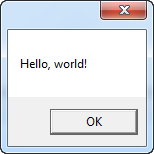
מעסעדזש באָקס מיט א טיטל
The above example might be a bit too bare minimum - a title on the window displaying the message would probably help. Fortunately, the second and optional parameter allows us to specify the title:
MessageBox.Show("Hello, world!", "My App");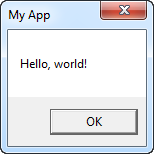
מעסעדזש באָקס מיט מערערע קנעפלעך
By default, the MessageBox only has the one Ok button, but this can be changed, in case you want to ask your user a question and not just show a piece of information. Also notice how I use multiple lines in this message, by using a line break character (\n):
MessageBox.Show("This MessageBox has extra options.\n\nHello, world?", "My App", MessageBoxButton.YesNoCancel);You control which buttons are displayed by using a value from the MessageBoxButton enumeration - in this case, a Yes, No and Cancel button is included. The following values, which should be self-explanatory, can be used:
- אקעי (OKׁׂ)
- אקעי בטל (OK Cancel)
- יא ניין בטל (Yes No Cancel)
- יא ניין (Yes No)
Now with multiple choices, you need a way to be able to see what the user chose, and fortunately, the MessageBox.Show() method always returns a value from the MessageBoxResult enumeration that you can use. Here's an example:
MessageBoxResult result = MessageBox.Show("Would you like to greet the world with a \"Hello, world\"?", "My App", MessageBoxButton.YesNoCancel);
switch(result)
{
case MessageBoxResult.Yes:
MessageBox.Show("Hello to you too!", "My App");
break;
case MessageBoxResult.No:
MessageBox.Show("Oh well, too bad!", "My App");
break;
case MessageBoxResult.Cancel:
MessageBox.Show("Nevermind then...", "My App");
break;
}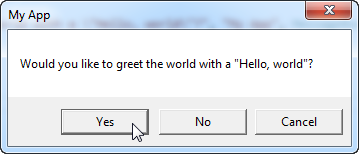
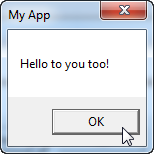
By checking the result value of the MessageBox.Show() method, you can now react to the user choice, as seen in the code example as well as on the screenshots.
מעסעדזש באָקס מיט אן אייקאָן
The MessageBox has the ability to show a pre-defined icon to the left of the text message, by using a fourth parameter:
MessageBox.Show("Hello, world!", "My App", MessageBoxButton.OK, MessageBoxImage.Information);Using the MessageBoxImage enumeration, you can choose between a range of icons for different situations. Here's the complete list:
- Asterisk
- Error
- Exclamation
- האנט (Hand)
- אינפארמאציע (Information)
- גארנישט (None)
- שאלה (Question)
- האלט (Stop)
- ווארענונג (Warning)
The names should say a lot about how they look, but feel free to experiment with the various values or have a look at this MSDN article, where each value is explained and even illustrated: http://msdn.microsoft.com/en-us/library/system.windows.messageboximage.aspx
MessageBox with a default option
The MessageBox will select a button as the default choice, which is then the button invoked in case the user just presses Enter once the dialog is shown. For instance, if you display a MessageBox with a "Yes" and a "No" button, "Yes" will be the default answer. You can change this behavior using a fifth parameter to the MessageBox.Show() method though:
MessageBox.Show("Hello, world?", "My App", MessageBoxButton.YesNo, MessageBoxImage.Question, MessageBoxResult.No);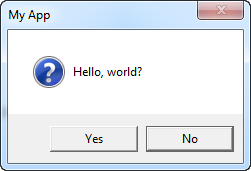
Notice on the screenshot how the "No" button is slightly elevated, to visually indicate that it is selected and will be invoked if the Enter or Space button is pressed.
דער גאנצע ביישפיל
ווי געזאגט, האט איר דא די גאנצע ביישפיל וואס איז גענוצט געווארן אין די ארטיקל
<Window x:Class="WpfTutorialSamples.Dialogs.MessageBoxSample"
xmlns="http://schemas.microsoft.com/winfx/2006/xaml/presentation"
xmlns:x="http://schemas.microsoft.com/winfx/2006/xaml"
Title="MessageBoxSample" Height="250" Width="300">
<StackPanel HorizontalAlignment="Center" VerticalAlignment="Center">
<StackPanel.Resources>
<Style TargetType="Button">
<Setter Property="Margin" Value="0,0,0,10" />
</Style>
</StackPanel.Resources>
<Button Name="btnSimpleMessageBox" Click="btnSimpleMessageBox_Click">Simple MessageBox</Button>
<Button Name="btnMessageBoxWithTitle" Click="btnMessageBoxWithTitle_Click">MessageBox with title</Button>
<Button Name="btnMessageBoxWithButtons" Click="btnMessageBoxWithButtons_Click">MessageBox with buttons</Button>
<Button Name="btnMessageBoxWithResponse" Click="btnMessageBoxWithResponse_Click">MessageBox with response</Button>
<Button Name="btnMessageBoxWithIcon" Click="btnMessageBoxWithIcon_Click">MessageBox with icon</Button>
<Button Name="btnMessageBoxWithDefaultChoice" Click="btnMessageBoxWithDefaultChoice_Click">MessageBox with default choice</Button>
</StackPanel>
</Window>using System;
using System.Windows;
namespace WpfTutorialSamples.Dialogs
{
public partial class MessageBoxSample : Window
{
public MessageBoxSample()
{
InitializeComponent();
}
private void btnSimpleMessageBox_Click(object sender, RoutedEventArgs e)
{
MessageBox.Show("Hello, world!");
}
private void btnMessageBoxWithTitle_Click(object sender, RoutedEventArgs e)
{
MessageBox.Show("Hello, world!", "My App");
}
private void btnMessageBoxWithButtons_Click(object sender, RoutedEventArgs e)
{
MessageBox.Show("This MessageBox has extra options.\n\nHello, world?", "My App", MessageBoxButton.YesNoCancel);
}
private void btnMessageBoxWithResponse_Click(object sender, RoutedEventArgs e)
{
MessageBoxResult result = MessageBox.Show("Would you like to greet the world with a \"Hello, world\"?", "My App", MessageBoxButton.YesNoCancel);
switch(result)
{
case MessageBoxResult.Yes:
MessageBox.Show("Hello to you too!", "My App");
break;
case MessageBoxResult.No:
MessageBox.Show("Oh well, too bad!", "My App");
break;
case MessageBoxResult.Cancel:
MessageBox.Show("Nevermind then...", "My App");
break;
}
}
private void btnMessageBoxWithIcon_Click(object sender, RoutedEventArgs e)
{
MessageBox.Show("Hello, world!", "My App", MessageBoxButton.OK, MessageBoxImage.Information);
}
private void btnMessageBoxWithDefaultChoice_Click(object sender, RoutedEventArgs e)
{
MessageBox.Show("Hello, world?", "My App", MessageBoxButton.YesNo, MessageBoxImage.Question, MessageBoxResult.No);
}
}
}